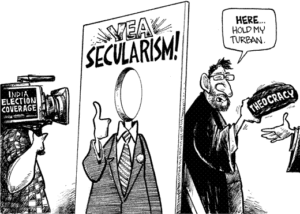The preamble to the Constitution of India claims India to be a SOCIALIST, SECULAR, DEMOCRATIC, REPUBLIC. What does it mean to call a country “Secular”? What does secularism imply? Is India really secular in practice? This article tries to find answers to all these questions.
Secularism has been defined differently in different countries in the world. The two ways in which it usually is understood are following:
- Separation of State and Religion – This concept can be found in practice in France where State has no religion. It neither favours nor condemns any religion, race, caste, sex or place of birth.
- Multiculturalism – This concept is in practice in India. In India too, by the virtue of being a secular State’ the State has no religion but it favours all religions. That in a way implies that the State has all religions.
It was the famous 42nd amendment which inserted the word “Secular” in the Preamble of our Constitution. How do we know that the concept of Secularism in India is different from that in France and other South Asian countries?
Right to freedom of Religion under our Constitution not only allows establishing religion based schools but these schools can also be subsidised by the State. Thus, State encourages all religions. State is not separate from religion.
Sometimes the State seems to be in a confused state! Rather State seems to be in a state which leaves citizens in a confused state. One very commonly talked about example is subsidy given to Muslims going for Haj which discriminates against those Hindus who go to their pilgrimage example; Vaishno Devi Yatra on their own expenses. Here, I am not advocating that the State should not give subsidy for Haj or should also give subsidy for Vaishno Devi Yarta or say Char Dham Yarta. All I am concerned with is the fact that in the effort of practicing multiculturalism State would knowingly or unknowingly end up favouring one section and discriminating against the other.
This reminds me of Article 48 of the Constitution which is although targeted towards organization of agriculture and animal husbandry but has raised different questions in the past. The intention of the State must have been clean in providing for prohibition on slaughter of cows and calves but this still has a potential to offend a group of people who enjoy having beef in their dinner plates. Since, cows are worshiped in Hiduism, although the State might not have intended such, the Article has the potential of being interpreted in a way that it favors a particular religion.
[quote]This again raises a question. If India has to be a “Secular” country as it has been added in the Preamble to the Constitution, which interpretation of Secularism is better?[/quote]
India is, no doubt, a diverse country. With so many religions, casts and communities, can State really practice multiculturalism? Can State actually support or encourage or subsidise activities of every religion that exists in the world’s seventh largest country with second largest population?

Well, respecting every counter opinion, to me “Separation of State and religion” seems a better option. Why not let each of them survive on their own? Why does State need to interfere in the matters of religion at all. This state interference has often given an opportunity to political parties use the pre-independence technique of ‘divide and rule’. Although Communal electorates have been abolished in India long back but votes from a particular constituency are often sought on the bases of caste, community, religion etc.to
[highlight]When preamble to the Constitution of a country uses the word “Secular”, it means the country is constituted in a way where all religions, races, casts and communities are treated equally. When, with such diversity, State finds it difficult to practice multiculturalism, it must give a thought to separate itself from all cultures to be able to do justice to all.[/highlight]


